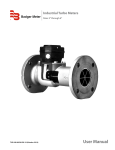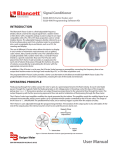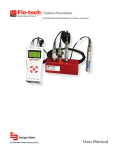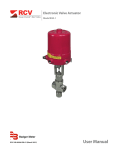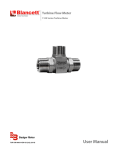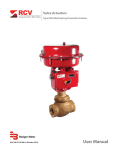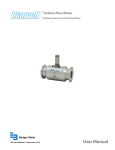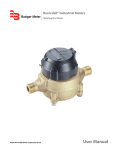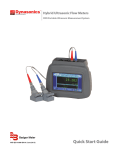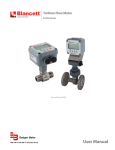Download User Manual - Instrumart
Transcript
Signal Conditioner B220-880 and B220-881 K Factor Scaler B220-880 B220-881 SGN-UM-00281-EN-02 (September 2014) User Manual Signal Conditioner, B220-880 and B220-881 K Factor Scaler Page ii September 2014 User Manual CONTENTS Introduction . . . . . . . . . . . . . . . . . . . . . . . . . . . . . . . . . . . . . . . . . . . . . . . . . . . . . . . . . . . . . . . . . . . . . . . . . 5 Operating Principle . . . . . . . . . . . . . . . . . . . . . . . . . . . . . . . . . . . . . . . . . . . . . . . . . . . . . . . . . . . . . . . . . . . . .5 Specifications . . . . . . . . . . . . . . . . . . . . . . . . . . . . . . . . . . . . . . . . . . . . . . . . . . . . . . . . . . . . . . . . . . . . . . . . 6 Installation . . . . . . . . . . . . . . . . . . . . . . . . . . . . . . . . . . . . . . . . . . . . . . . . . . . . . . . . . . . . . . . . . . . . . . . . . . 7 Enclosure Mounting (necessary for CSA certification) . . . . . . . . . . . . . . . . . . . . . . . . . . . . . . . . . . . . . . . . . . . . 7 Power . . . . . . . . . . . . . . . . . . . . . . . . . . . . . . . . . . . . . . . . . . . . . . . . . . . . . . . . . . . . . . . . . . . . . . . . . . .7 Turbine Meter . . . . . . . . . . . . . . . . . . . . . . . . . . . . . . . . . . . . . . . . . . . . . . . . . . . . . . . . . . . . . . . . . . . . . 7 Pulse Output . . . . . . . . . . . . . . . . . . . . . . . . . . . . . . . . . . . . . . . . . . . . . . . . . . . . . . . . . . . . . . . . . . . . . .8 Startup And Configuration . . . . . . . . . . . . . . . . . . . . . . . . . . . . . . . . . . . . . . . . . . . . . . . . . . . . . . . . . . . . . . . .9 Setting the K Factor . . . . . . . . . . . . . . . . . . . . . . . . . . . . . . . . . . . . . . . . . . . . . . . . . . . . . . . . . . . . . . . . . .9 Setting the Output Pulse Width . . . . . . . . . . . . . . . . . . . . . . . . . . . . . . . . . . . . . . . . . . . . . . . . . . . . . . . . . .9 Setting the Output Level . . . . . . . . . . . . . . . . . . . . . . . . . . . . . . . . . . . . . . . . . . . . . . . . . . . . . . . . . . . . . 10 Setting the Internal or External Pullup Resistor . . . . . . . . . . . . . . . . . . . . . . . . . . . . . . . . . . . . . . . . . . . . . . . 10 Pulse Output . . . . . . . . . . . . . . . . . . . . . . . . . . . . . . . . . . . . . . . . . . . . . . . . . . . . . . . . . . . . . . . . . . . . .10 Internal Pullup Resistor . . . . . . . . . . . . . . . . . . . . . . . . . . . . . . . . . . . . . . . . . . . . . . . . . . . . . . . . . . . . . . 11 External Pullup Resistor . . . . . . . . . . . . . . . . . . . . . . . . . . . . . . . . . . . . . . . . . . . . . . . . . . . . . . . . . . . . . . 12 K Factors Explained . . . . . . . . . . . . . . . . . . . . . . . . . . . . . . . . . . . . . . . . . . . . . . . . . . . . . . . . . . . . . . . . . . . .13 Calculating K factors . . . . . . . . . . . . . . . . . . . . . . . . . . . . . . . . . . . . . . . . . . . . . . . . . . . . . . . . . . . . . . . . 13 September 2014 Page iii Signal Conditioner, B220-880 and B220-881 K Factor Scaler Page iv September 2014 Introduction INTRODUCTION The Blancett K Factor Scaler is a field adjustable frequency divider, which interfaces the output signal from a turbine meter with a magnetic pickup to the input of a PLC, RTU, CPU data acquisition card or similar totalizer device. The adjustable frequency divisor, referred to as the K factor, allows the pulses being sent from a turbine meter to be divided into a recognizable unit that an end device, such as a PLC, can count and display. Different K factors allow the device to display in any number of volume measurements such as gallons, cubic meters, liters, barrels, and like units. A calibration sheet provided with a turbine meter lists a nominal K factor or other frequency information specific to that particular flow meter, tested to a specific volumetric flow rate. This K factor can be placed directly into the K Factor Scaler to provide an output with the same volumetric flow rate or modified to a different volumetric flow rate by recalculating the K factor with the appropriate conversion factor. In addition, if the K factor is set to one, the K Factor Scaler can be used as a preamplifier where the frequency from a low level turbine meter is proportional to the logic level frequency output needed by a PLC or CPU data acquisition card. This option allows the end device to control the dividing process of the turbine meter output to a recognizable flow rate. OPERATING PRINCIPLE Fluid moving though a turbine flow meter causes the rotor to rotate in relation to the flow rate. The rotation of the rotor blades cuts through the magnetic field generated by the magnetic pickup, which in turn generates a frequency output signal that is directly proportional to the speed of the rotor. Magnetic Pickup or Other Frequency Output Device Turbine Rotor Output Signal Figure 1: Schematic illustration of electric signal generated by rotor movement The signal produced is received by the K Factor Scaler input amplifier, which has an input sensitivity of 30 mV p-p…30V p-p. The signal is then sent to an onboard microcontroller, which acts as a divisor with a range of 1…999,999,999. The divisor (K factor) is user adjustable and set by programming it into the board. The microcontroller handles the dividing process by counting the input pulses and comparing it to the programmed K factors. Once the count equals this value, an output pulse occurs for a selectable time period and the counting process starts over. September 2014 SGN-UM-00281-EN-02 Page 5 Specifications SPECIFICATIONS FOR THIS DEVICES CSA RATING TO BE VALID, THE CIRCUIT BOARD MUST BE MOUNTED IN A CERTIFIED APPLETON 1 IN. MODEL GRL100-A OR GRLB100-A CONDUIT OUTLET BOX. External Power Input Voltage 8.5…30V DC (diode protected). Maximum Current Draw 18 mA (using internal resistor @ 30V DC input). Environmental Operating Temperature Inputs (Magnetic Pickup) –22…158° F (–30…70° C). Frequency Range 0…4000 Hz. Trigger Sensitivity 30 mV p-p…30V p-p. Output Signal Max Voltage 30V DC. Max Power 0.25 W. Pulse Output (using internal pullup resistor) Maximum Current 8 mA. VH = Power input voltage – 0.7V DC. VL = Less then 0.4V @ maximum input power. Internal Pullup Resistor 3.6 kΩ (enabled/disabled by jumper). Pulse Output (using external pullup resistor) Maximum Current 100 mA. VH = Input voltage to external pullup resistor. VL = [VH /(selected resistor value + 47 Ω)] × 47 Ω. Pulse Length 150 µs, 1 ms, 25 ms, 100 ms, 500 ms, 1 s, or auto mode. Enclosure Appleton GR Conduit Outlet Box GRL100-A and GRLB100-A explosion proof; dust/ignition proof. Agency Listings Hazardous Locations. CSA Class I, Div 1, Groups B, C and D; Class II, Groups E, F, and G; and Class III. Type 4X; T6 @ 70° C. C22.2 No. 30 for Canada. Pollution Degree 2 Overvoltage Category III Page 6 Normally only non-conductive pollution occurs. Occasionally, a temporary conductivity caused by condensation must be expected. Distribution level, fixed installation, with smaller transient overvoltage than installation category IV (Primary supply level). SGN-UM-00281-EN-02 September 2014 Installation INSTALLATION The K Factor Scaler was designed with terminal connections with removable plugs for easy connection and removal from the system after installation. Refer to Figure 2 for the I/O terminal connections. The board connections include power input, turbine meter input, and the pulse output to a totalizing device. DIP Switches (for selecting pulse width, pulse state and pullup resistor options) P1 Power Input 8.5…30V DC ON C&K SDA05 0 1 9, 9 9 0 1 7 8 7 8 7 8 7 8 5 6 7 8 9 2 3 4 5 6 7 8 0 1 2 3 4 5 6 7 8 9 2 3 9 0 1 2 3 4 5 6 7 8 9 2 3 2 3 9, 9 0 1 4 9 5 6 0 1 4 9 2 3 2 3 4 5 6 9 0 1 5 6 9 4 0 1 5 6 9 1 2 3 4 5 9 4 Pulse Output S10 9 P2 P4 Turbine Meter Input Factory Use Only Figure 2: Input/Output terminal connections Enclosure Mounting (necessary for CSA certification) If the circuit board assembly is supplied without an enclosure, it must be mounted within a certified Appleton one inch NPT model GRL100-A or GRLB100-A conduit outlet box to maintain the CSA “Ordinary Locations” certification. The label containing the hookup information should be placed on the inside of the cover of the enclosure. The label containing the CSA logo should be placed on the bottom exterior of the enclosure. Power The K Factor Scaler requires 8.5…30V DC to operate. The power connections are reverse polarity protected by a diode, but must be connected properly for operation of the device. Polarity is shown in Figure 2. Turbine Meter The turbine meter connections are non-polarized and located on a separate 2-position terminal. Shielded, twisted pair wire is recommended for this connection. September 2014 SGN-UM-00281-EN-02 Page 7 Installation Pulse Output Either the internal pullup resistor or an external resistor must be used for the K Factor Scaler to provide an output pulse. This option is controlled by position 5 of the DIP switch. Internal Pull-up Resistor The internal pullup resistor allows for a simple installation, but care must be taken to ensure that the device being connected to by the pulse output can handle voltage levels as high as the power feeding the K Factor Scaler. Another important setup consideration when using the internal pullup resistor is to make sure the output pulse from the K Factor Scaler can supply enough current for the receiving device to be able to read the pulse. The available current that the K Factor Scaler can supply the receiving device can be calculated with the following equation. Available Current = (Input Voltage - 0.7V) (3600Ω + 47Ω) Verify that the receiving device input current requirement is below this value for proper operation. Otherwise, an external pullup resistor less than 3.6 kΩ will have to be used. External Pull-up Resistor Using an external pullup resistor offers the user greater flexibility of controlling the output pulse provided by the K Factor Scaler to a receiving device. Since power sources and receiving devices differ between users, different resistor values may be required by different setups. The external pullup resistor is connected between the receiving device’s input and a power source. This power source would be the maximum input voltage (of the pulse) to the receiving device. Refer to the following equation to help determine the resistor value needed. R = Supply Voltage Current Where: R = Resistor value in ohms (Ω) Supply Voltage = External supply voltage connected to the external pullup resistor Current = Input current required by the receiving device in amps After the resistor value has been calculated, make sure in the following equation, that “P” is less than or equal to 0.25. “P” represents the power capability of the output and should not exceed 0.25 Watts. Exceeding this value could damage the K Factor Scaler. Raising the resistor value will decrease the power requirement. Supply Voltage P = ( Supply Voltage ) R + 47 Ω Page 8 SGN-UM-00281-EN-02 September 2014 Startup And Configuration STARTUP AND CONFIGURATION After the K Factor Scaler has been properly installed, power can be applied. The unit can be configured with the power either on or off. If the power is on, the onboard microcontroller constantly scans for any changes and adjusts accordingly. Note that the pulse output should be ignored while any changes are being made with the power applied. Any changes cause the internal counter to reset and the dividing process to start over. Configuring the K Factor Scaler consists of the following four items: 1. Setting the K factor (divider) 2. Setting the output pulse width 3. Setting the pulse output level normally high or normally low 4. Setting the output pulse to use the internal or external pullup resistor Setting the K Factor The K factor is the ratio of input pulses per each output pulse and can be viewed as a divisor. The minimum K factor can be set to 1 where each input pulse yields an output pulse. The maximum K factor can be set to 999,999,999 where it would take this many input pulses to yield one output pulse. The K factor is set using the eight rotary switches. Each switch is a ten position switch that is used to select a number from 0 to 9 by pointing the arrow to the corresponding digit inscribed on its casing. When looking at the K Factor Scaler board so that the text 99,999,999 is below the switches, the right most switch represents the least significant digit of the K factor number (see Figure 2). For example, to set the K factor as 4572, the switches should be set as shown in Figure 3. 4, 5 0 1 9 7 0 1 7 8 7 8 7 8 7 8 5 6 7 8 9 2 3 4 5 6 7 8 0 1 2 3 4 5 6 7 8 9 2 3 9 0 1 2 3 4 7 8 9 2 3 2 3 2 3 2 3 4 5 6 9, 9 5 6 9 0 1 4 9 5 6 0 1 4 9 5 6 0 1 4 9 5 6 0 1 4 9 2 Figure 3: Setting the rotary switches Setting the Output Pulse Width The output pulse width is the length of time the pulse remains active before resetting to its resting state. The K Factor Scaler has a total of six different pulse widths to choose from. Some end devices require that the pulse be a certain length or longer in order for proper detection of each incoming pulse. For these devices, it is important to select a pulse width that is long enough for the end device to recognize. DIP Switch The pulse width options are selected by the DIP switch positions 1, 2 and 3. Table 1 shows the position of each switch to select the desired pulse width output. Pulse Width 150 µs 1 ms 25 ms 100 ms 500 ms 1s Auto Factory Test 1 ▼ ▲ ▼ ▲ ▼ ▲ ▼ ▲ DIP Switch 2 ▼ ▼ ▲ ▲ ▼ ▼ ▲ ▲ 3 ▼ ▼ ▼ ▼ ▲ ▲ ▲ ▲ ON C & K SDA05 1 2 3 4 5 Table 1: DIP switch settings for selecting the width of the output pulse September 2014 SGN-UM-00281-EN-02 UP (ON) DOWN (OFF) Figure 4: Pulse width settings Page 9 Startup And Configuration Setting the Output Level Most end devices are unaffected by this setting, but the K Factor Scaler board has the ability to invert the output pulse level. This option is controlled by position 4 of the DIP switch. When the switch is in the off position (down, in reference to Figure 6), the output level is normally low and the duration of the selected pulse width is high. When the switch is in the on position (up, in reference to Figure 6), the output level is normally high and the duration of the selected pulse width is low. ON C & K SDA05 Switch 4 Switch 5 Function Function Output (Normally High) ▲ Internal Pullup used Output (Normally Low) ▼ External Pullup required 1 2 3 4 5 ▲ ▼ Table 2: Switch 4 and 5 settings UP (ON) DOWN (OFF) Figure 5: Switch 4 settings ON C&K SDA0 5 1 2 3 4 5 UP (ON) DOWN (OFF) Figure 6: Switch 5 settings Setting the Internal or External Pullup Resistor Either the internal pullup resistor or an external resistor must be used for the K Factor Scaler board to provide an output pulse. This option is controlled by position 5 of the DIP switch. When DIP switch 5 is in the on position (up, in reference to Figure 6), the internal 3.6 kΩ pullup resistor is connected to the input voltage of the board. The output pulse swing is approximately 0.7 volts less than the input voltage to near zero volts. Setting DIP switch 5 in the off position (down, in reference to Figure 6), the internal pullup resistor is disconnected and an external pullup resistor and supply voltage are required. Pulse Output Either the internal or an external pullup resistor is required for the K Factor Scaler to provide an output pulse. An onboard jumper controls the pullup resistor selection. With the jumper installed, the internal pullup resistor is connected. Without the jumper, an external pullup is required. Refer to Table 2 for the I/O terminal connections. Page 10 SGN-UM-00281-EN-02 September 2014 Startup And Configuration Internal Pullup Resistor The internal pullup resistor allows for a simple installation, but be careful to ensure that the device being connected to the pulse output can accept voltage levels as high as the supply feeding the K Factor Scaler. Another important setup consideration when using the internal pullup resistor is to make certain the output pulse from the K Factor Scaler can supply enough current for the receiving device to read the pulse. Calculation of the available current that the K Factor Scaler can supply to the receiving device uses the following equation (see Figure 7). (Input Voltage - 0.7V) Available Current = (3600Ω + 47Ω) Using the above equation the maximum current available at an input voltage of 30V is 8 mA. Verify that the receiving device input current requirement is below this value for proper operation. Otherwise, an external pullup resistor less than 3.6 kΩ is required. Vin Internal 3.6k Ω P1 Open Collector Pulse Output 9 0 1 7 8 7 8 9, 9 0 1 7 8 7 8 7 8 5 6 4 5 6 7 8 9 2 3 4 5 6 7 8 0 1 2 3 4 5 6 7 8 9 2 3 9 0 1 2 3 2 3 9, 9 9 4 9 5 6 0 1 TB1 4 0 1 5 6 9 2 3 2 3 4 5 6 9 0 1 4 9 5 6 0 1 1 2 3 4 5 9 4 9 2 3 8 mA Maximum ON C & K S DA 0 5 S10 9 P2 ON C & K SDA 0 5 P4 1 2 3 4 5 Switch 5 On (Up) Figure 7: Wiring schematic with internal pullup resistor in circuit September 2014 SGN-UM-00281-EN-02 Page 11 Startup And Configuration External Pullup Resistor Using an external pullup resistor offers the end user greater flexibility in controlling the output pulse provided by the K Factor Scaler. Power sources and receiving devices differ in individual situations. This fact requires the use of different pullup resistor values. Connection of the external pullup resistor is between the receiving device’s input and external power source (see Figure 8). The power source voltage is the maximum input voltage (of the pulse) to the receiving device. Refer to the following equation to help determine the pullup resistor value needed. Supply Voltage R = Current Where: R = Resistor value in ohms Supply Voltage = External supply voltage connected to the external pullup resistor Current = Input current required by the receiving device in amps After the resistor value is calculated, make sure in the following equation that power (P) is less than or equal to 0.25 Watts. P represents the output power capability. This value should not exceed 0.25 Watts. Damage to the K Factor Scaler circuit is likely by exceeding this value. Raising the resistor value will decrease the available power output and safeguard the circuit. +V 250…10k Pullup Resistor Open Collector Pulse Output ON C &K SDA0 5 S10 5 6 9 0 1 7 8 7 8 9, 9 0 1 7 8 7 8 7 8 4 4 5 6 7 8 9 2 3 4 5 6 7 8 1 2 3 4 5 0 1 2 3 4 5 6 7 8 9 2 3 9 0 1 2 3 2 3 9, 9 9 5 6 0 1 TB1 9 4 0 1 5 6 9 2 3 2 3 4 5 6 9 0 1 4 9 5 6 0 1 9 4 9 2 3 100 mA Maximum Internal P1 9 P2 ON C&K SDA05 P4 1 2 3 4 5 Switch 5 Off (Down) Figure 8: Wiring schematic using an external pullup resistor To determine the maximum current available using a specific pullup resistor use the following equation. Current Draw = Page 12 0.25 Watts External Pullup Resistor SGN-UM-00281-EN-02 September 2014 K Factors Explained K FACTORS EXPLAINED The K factor (with regards to flow) is the number of pulses that must be accumulated to equal a particular volume of fluid. You can think of each pulse as representing a small fraction of the totalizing unit. An example might be a K factor of 1000 (pulses per gallon). This means that if you were counting pulses, when the count total reached 1000, you would have accumulated one gallon of liquid. Using the same reasoning, each individual pulse represents an accumulation of 1/1000 of a gallon. This relationship is independent of the time it takes to accumulate the counts. The frequency aspect of K factors is a little more confusing because it also involves the flow rate. The same K factor number, with a time frame added, can be converted into a flow rate. If you accumulated 1000 counts (one gallon) in one minute, then your flow rate would be one gpm. The output frequency, in Hz, is found simply by dividing the number of counts (1000) by the number of seconds in a minute (60) to get the output frequency. 1000 ÷ 60 = 16.6666 Hz. If you were looking at the pulse output on a frequency counter, an output frequency of 16.666 Hz would be equal to one gpm. If the frequency counter registered 33.333 Hz (2 × 16.666 Hz), then the flow rate would be two gpm. Finally, if the flow rate is two gpm, then the accumulation of 1000 counts would take place in 30 seconds because the flow rate, and hence the speed that the 1000 counts is accumulated, is twice as great. Calculating K factors Many styles of flow meters are capable of measuring flow in a wide range of pipe sizes. Because the pipe size and volumetric units the meter will be used on vary, it may not possible to provide a discrete K factor. In the event that a discrete K factor is not supplied then the velocity range of the meter is usually provided along with a maximum frequency output. The most basic K factor calculation requires that an accurate flow rate and the output frequency associated with that flow rate be known. Example 1 Known values are: Frequency = 700 Hz Flow Rate = 48 gpm 700 Hz × 60 sec = 42,000 pulses per min K factor = 42,000 pulses per min 48 gpm Example 2 Known values are: Full Scale Flow Rate Full Scale Output Frequency = = = 875 pulses per gallon 85 gpm 650 Hz 650 Hz × 60 sec = 39,000 pulses per min K factor = 39,000 pulses per min 85 gpm = 458.82 pulses per gallon The calculation is a little more complex if velocity is used because you first must convert the velocity into a volumetric flow rate to be able to compute a K factor. To convert a velocity into a volumetric flow, the velocity measurement and an accurate measurement of the inside diameter of the pipe must be known. Also needed is the fact that one US gallon of liquid is equal to 231 cubic inches. September 2014 SGN-UM-00281-EN-02 Page 13 K Factors Explained Example 3 Known values are: Velocity= 4.3 ft/sec Inside Diameter of Pipe = 3.068 in. Find the area of the pipe cross section. Area = πr2 2 3.068 2 Area = π = π x 2.35 = 7.39 in 2 Find the volume in one foot of travel. 7.39 in2 x 12 in. (1 ft) = 88.71in2 ft What portion of a gallon does one foot of travel represent? 88.71 in3 231 in3 = 0.384 gallons So for every foot of fluid travel 0.384 gallons will pass. What is the flow rate in gpm at 4.3 ft/sec? 0.384 gallons × 4.3 FPS × 60 sec (1 min) = 99.1 gpm Now that the volumetric flow rate is known, all that is needed is an output frequency to determine the K factor. Known values are: Frequency = 700 Hz (By measurement) Flow Rate = 99.1 gpm (By calculation) 700 Hz × 60 sec = 42,000 pulses per gallon K factor = Page 14 42,000 pulses per min 99.1 gpm = 423.9 pulses per gallon SGN-UM-00281-EN-02 September 2014 K Factors Explained INTENTIONAL BLANK PAGE September 2014 SGN-UM-00281-EN-02 Page 15 Control. Manage. Optimize. BLANCETT is a registered trademark of Badger Meter, Inc. Other trademarks appearing in this document are the property of their respective entities. Due to continuous research, product improvements and enhancements, Badger Meter reserves the right to change product or system specifications without notice, except to the extent an outstanding contractual obligation exists. © 2014 Badger Meter, Inc. All rights reserved. www.badgermeter.com The Americas | Badger Meter | 4545 West Brown Deer Rd | PO Box 245036 | Milwaukee, WI 53224-9536 | 800-876-3837 | 414-355-0400 México | Badger Meter de las Americas, S.A. de C.V. | Pedro Luis Ogazón N°32 | Esq. Angelina N°24 | Colonia Guadalupe Inn | CP 01050 | México, DF | México | +52-55-5662-0882 Europe, Middle East and Africa | Badger Meter Europa GmbH | Nurtinger Str 76 | 72639 Neuffen | Germany | +49-7025-9208-0 Europe, Middle East Branch Office | Badger Meter Europe | PO Box 341442 | Dubai Silicon Oasis, Head Quarter Building, Wing C, Office #C209 | Dubai / UAE | +971-4-371 2503 Czech Republic | Badger Meter Czech Republic s.r.o. | Maříkova 2082/26 | 621 00 Brno, Czech Republic | +420-5-41420411 Slovakia | Badger Meter Slovakia s.r.o. | Racianska 109/B | 831 02 Bratislava, Slovakia | +421-2-44 63 83 01 Asia Pacific | Badger Meter | 80 Marine Parade Rd | 21-06 Parkway Parade | Singapore 449269 | +65-63464836 China | Badger Meter | 7-1202 | 99 Hangzhong Road | Minhang District | Shanghai | China 201101 | +86-21-5763 5412 Legacy Document Number: 02-SGN-UM-00116
















